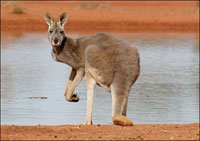| ||||||||||||||||||||||||||||||||||||||||
|
Have you ever thought that this animal could help fight global warming? Thanks to special bacteria in their stomachs, kangaroo flatulence contains no methane2 and scientists want to transfer that bacteria to cattle and sheep who emit large quantities of the harmful gas. While the usual image of greenhouse gas pollution is a billowing smokestack pushing out carbon dioxide, livestock3 passing wind contribute a surprisingly high percentage of total emissions4 in some countries. "Fourteen percent of emissions from all sources in Australia is from enteric methane from cattle and sheep," said Athol Klieve, a senior research scientist with the Queensland state government. "And if you look at another country such as New Zealand, which has got a much higher agricultural base, they're actually up around 50 percent," he said. Researchers say the bacteria also makes the digestive process much more efficient and could potentially save millions of dollars in feed costs for farmers. But it will take researchers at least three years to isolate5 the bacteria, before they can even start to develop a way of transferring it to cattle and sheep. Another group of scientists, meanwhile, has suggested Australians should farm fewer cattle and sheep and just eat more kangaroos. The idea is controversial, but about 20 percent of health conscious Australians are believed to eat the national symbol already. "It's low in fat, it's got high protein levels and it's very clean in the sense that basically it's the ultimate free range animal," said Peter Ampt of the University of New South Wales's institute of environmental studies.
为了减少导致全球变暖的温室气体的排放,澳大利亚科学家目前正在想办法将牛羊胃变成袋鼠式的胃。 袋鼠胃中有一种特殊的细菌能使其放的屁中不含有甲烷。科学家想将这种细菌移至牛羊的胃中,以抑制它们所排放的大量有害气体。 说到二氧化碳等温室气体的排放,人们脑中通常会出现一个大烟囱冒出滚滚浓烟的画面。但在一些国家,牲畜放的屁在温室气体排放总量中所占的比例十分惊人。 昆士兰州政府的高级科研人员阿索尔•克里弗说:“在澳大利亚,牛羊排放的甲烷占温室气体排放总量的14%。” “而在农业更为发达的新西兰,这一比例则高达约50%。” 研究人员称,袋鼠胃中所含的那种细菌还可以促进消化,从而能为农民节省几百万美元的饲料成本。 但科学家至少得用三年的时间分离出这种细菌,然后还得设法将其移至牛羊的胃中。 此外,另一组科学家建议澳大利亚人应少养牛羊,多吃袋鼠肉。 尽管这一观点有争议,但目前约有20%健康意识较强的澳大利亚人已经吃上了被视为“国家象征”的袋鼠。 新南威尔士大学环境研究所的彼特•阿姆普特说:“袋鼠肉富含蛋白质,脂肪含量低。而且由于袋鼠是散养动物,所以它的肉很干净。”
Vocabulary: free range animal:animal that are not locked up(散养动物;非圈养动物) 点击  收听单词发音 收听单词发音
|
||||||||||||||||||||||||||||||||||||||||
- 发表评论
-
- 最新评论 进入详细评论页>>




